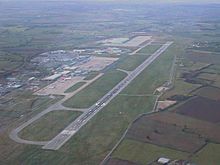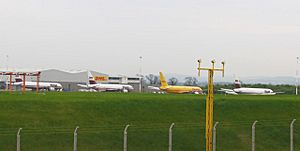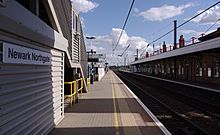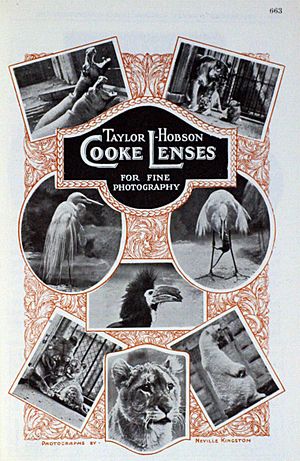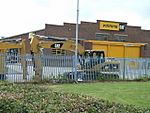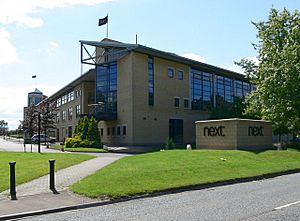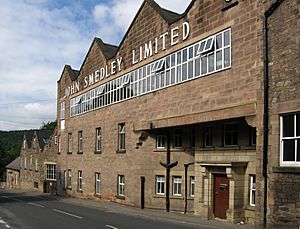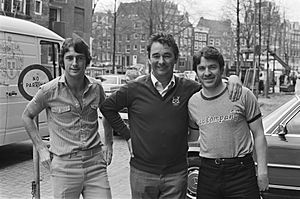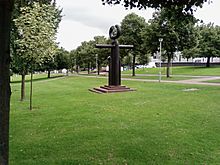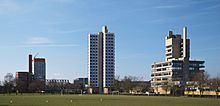East Midlands facts for kids
Quick facts for kids
East Midlands
|
|
|---|---|
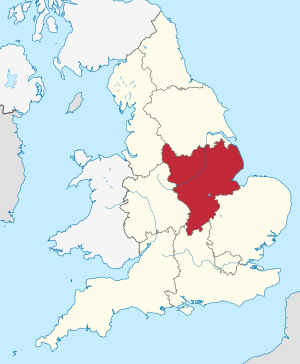 |
|
| Sovereign state | United Kingdom |
| Constituent country | England |
| Largest city | Leicester |
| Largest urban area | Nottingham Urban Area |
| Area | |
| • Total | 6,034 sq mi (15,627 km2) |
| Area rank | 4th |
| Population
(2018 est.)
|
|
| • Total | 4,804,149 |
| • Rank | 8th |
| • Density | 796.230/sq mi (307.426/km2) |
| GVA | |
| • Total | £88 billion |
| • Per capita | £17,698 (5th) |
| ITL code | TLF |
| ONS code | E12000004 |
The East Midlands is one of nine official regions of England. It is used for statistical purposes. This area covers the eastern part of the traditional Midlands. It includes the counties of Derbyshire, Leicestershire, Lincolnshire (except for North and North East Lincolnshire), Northamptonshire, Nottinghamshire, and Rutland. The region is about 15,627 square kilometres (6,034 sq mi) in size. In 2011, it had a population of over 4.5 million people.
The biggest towns and cities in the region are Derby, Leicester, Lincoln, Mansfield, Northampton, and Nottingham. Other important places include Boston, Buxton, Chesterfield, Corby, Grantham, Kettering, and Loughborough. The East Midlands is a strong economic area. This is because it is close to London and the big cities in the north. It also has good motorway and road networks.
Nottingham is the only city in the region that is ranked as a "sufficiency-level world city". This means it is important on a global scale. The main airport for the region is East Midlands Airport. It is located between Derby, Leicester, and Nottingham.
Contents
Geography of the East Midlands
The highest point in the East Midlands is Kinder Scout. It is 636 metres (2,087 ft) high. You can find it in the Peak District in northwest Derbyshire. Other hilly areas are between 95 and 280 metres (312 and 919 ft) high. These areas include Charnwood Forest and the Lincolnshire Wolds. There are also many lakes and reservoirs.
The main rivers in the region are the Nene, the Soar, the Trent, and the Welland. They all flow northeast towards the Humber and the Wash. The Derwent starts in the High Peak. It flows south to join the Trent.
The middle of the East Midlands is roughly between Bingham and Bottesford. The exact geographical centre of England is in Higham on the Hill. This is in west Leicestershire. About 88% of the land is countryside. However, farming provides less than three percent of the jobs.
Lincolnshire is the only county with a coastline. It has about 30 miles (48 km) of North Sea coast. The first Ordnance Survey trig point was set up in April 1936. This was in Cold Ashby in Northamptonshire.
The Royal Society of Wildlife Trusts and The Wildlife Trusts have their offices in Newark-on-Trent. The National Centre for Earth Observation is at the University of Leicester.
Rocks and Minerals of the East Midlands
The region has a lot of limestone. It also has the East Midlands Oil Province, where oil is found. Charnwood Forest is famous for its volcanic rocks. These rocks are estimated to be around 600 million years old.
About 25% of the UK's cement is made here. This happens at three large sites in Hope and Tunstead in Derbyshire. Another site is the Ketton Cement Works in Rutland. Derbyshire provides 25% of the region's aggregates. Leicestershire provides 40%. Lincolnshire and Nottinghamshire each produce about 30% of the region's sand and gravel.
Barwell in Leicestershire had Britain's largest meteorite fall in 1965. It weighed 7 kilograms (15 lb). The 2008 Lincolnshire earthquake had a magnitude of 5.2.
Nature and Environment
The East Midlands Biodiversity Partnership has named several areas as important for nature. These are called Biodiversity Conservation Areas. They include:
- Charnwood Forest
- Coversand Heaths
- Derbyshire Peak Fringe and Lower Derwent
- Humberhead Levels
- Leighland Forest
- The Lincolnshire Limewoods and Heaths
- The Lincolnshire Coast
- The Peak District
- Rockingham Forest
- Sherwood Forest
- Rutland, SW Lincolnshire and N Northamptonshire
- The Wash
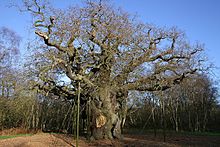
Areas named as Biodiversity Enhancement Areas include:
- The Coalfields
- The Daventry Grasslands
- The Fens
- The Lincolnshire Coastal Grazing Marshes
- The Lincolnshire Wolds
- The National Forest
- The Yardley-Whittlewood Ridge
Two areas in the East Midlands are designated as Areas of Outstanding Natural Beauty. These are:
- The Peak District
- The Lincolnshire Wolds
Forests and Woodlands
Many towns in the southern part of the region are within what was once Rockingham Forest. This was a royal forest used for hunting by kings and queens. William the Conqueror first named it a royal hunting forest.
The National Forest is a big environmental project. It covers about 200 square miles (520 km2) in north Leicestershire, south Derbyshire, and southeast Staffordshire. The goal is to plant new trees and connect old woodlands. It stretches from Leicester to Burton upon Trent.
Sherwood Forest in Nottinghamshire is very popular. It is famous for its connection to the legend of Robin Hood.
People and Cities
The biggest cities and towns in the East Midlands are Leicester, Nottingham, Derby, Northampton, Chesterfield, Lincoln, Mansfield, Loughborough, and Kettering. Leicester is the largest city. The Nottingham Urban Area is the largest group of connected towns and cities.
Travel and Transport
About nine percent of all jobs in the region are in logistics. This means moving goods around. Traffic in the region is growing faster than in other UK regions. Around 140,000 heavy goods vehicles travel here every day.
Roads
The M1 motorway connects the four largest urban areas. It links the region to London, Yorkshire, and North East England. The M6 starts in the southwest of the region. It links to the West Midlands and North West England. These motorways connect to other major roads across the UK.
To the east, the A1 road is important for travel to ports on England's northeast coast. It is also a key road for farming. The A46 follows an old Roman road, the Fosse Way. This road has linked the southwest and northeast of England since Roman times. The A43 connects the East Midlands to Oxford and southern England. The historic A5 runs along the southwest Leicestershire border. The A14 goes through north Northamptonshire. It links the region to the East of England, including Cambridge and the port of Felixstowe.
Airports
East Midlands Airport is near the region's largest cities. It is about 14 miles (23 km) from Derby and Nottingham. Leicester is about 21 miles (34 km) away. Lincoln is 43 miles (69 km) away. Over 4 million passengers use this airport each year.
There has been a long discussion about the airport's name. This is because of the friendly competition between the three biggest cities. The name was once changed to Nottingham East Midlands Airport. This was to include the name of the city thought to be most famous internationally. However, the airport has a Derby phone number and postcode, and is in Leicestershire. So, the name was changed back.
Three of the world's four main international air-freight companies have their UK operations at East Midlands Airport. These are DHL, UPS, and TNT Express. It is the second-largest freight airport in the UK after Heathrow. Most freight from this airport is carried on special cargo planes. Royal Mail also uses East Midlands Airport as a main hub. This is because it is close to the M1 and other major roads. Air freight at the airport grew a lot from 1994 to 2004. It went from about 10,000 to over 250,000 tonnes.
Smaller airports in the region include Retford Gamston Airport, Nottingham Airport, and Leicester Airport.
Railways
Three main railway lines serve the region. These are the Midland Main Line, the East Coast Main Line, and the West Coast Main Line. They provide fast services to London St Pancras, London King's Cross, and London Euston. Trains can travel up to 125 miles per hour (201 km/h). They serve towns like Wellingborough, Kettering, Leicester, Derby, Nottingham, and Chesterfield.
A land speed record for trains was broken in the region. The fastest speed for a steam train was set by the Mallard in 1938. It reached 126 miles per hour (203 km/h) between Grantham and Peterborough. This record was not broken by any British train until 1973.
There are plans for a new high-speed rail line, High Speed 2, to come through the East Midlands. This line would connect Birmingham to Leeds. A new station, the East Midlands Hub, is planned for Toton.
Waterways
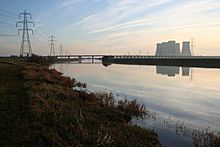
The Trent is a navigable river. It is used to transport goods to the Humber. Many power stations are located along the Trent. It is the only river in England that can provide cooling water for power stations along most of its length. It has the largest water capacity in England.
Some early Rolls-Royce jet engines were named after rivers in the region. These include the Nene, the Welland, and the Soar.
Trams
Nottingham is the only city in the region with a tram system. It is called Nottingham Express Transit.
History of the East Midlands
Roman Times
The area of the East Midlands was once home to the Corieltauvi tribe. When the Romans arrived, they made Leicester one of their main forts. It was called Ratae Corieltauvorum. The most important Roman town in the region was Lincoln. It was located where the Fosse Way and Ermine Street met.
Vikings and Anglo-Saxons
This region also matches the later Five Boroughs of the Danelaw. These were areas ruled by Vikings. It was also the eastern part of the Anglian Kingdom of Mercia. Around 917, the region was divided between the Vikings (Danelaw) in the north and the Saxons (Mercia) in the south. By 920, this border moved further north to the River Humber. You can still see evidence of the Danelaw in the names of villages, especially in the east.
English Civil War
Two important battles of the English Civil War took place here. The Battle of Naseby was in northern Northamptonshire in 1645. The Battle of Winceby was in eastern Lincolnshire in 1643.
Scientific Discoveries
Isaac Newton, born in Grantham in 1642, was a very famous scientist. He developed Calculus, Newton's laws of motion, and Newton's law of universal gravitation.
Henry Cavendish, who had connections to Derbyshire, discovered hydrogen in 1766. He also accurately estimated the mass of the Earth in 1798. George Boole, born in Lincoln in 1815, created Boolean logic. This is the basis for all digital electronics and computers.
The first practical demonstration of radar happened near Daventry in 1935. Silicone was invented in 1899 by Professor Frederic Kipping at University College, Nottingham. Michael Creeth of Northampton discovered how DNA bases connect. This helped to find the structure of DNA.
Louis Essen, a physicist from Nottingham, made big improvements to clocks. He invented the atomic clock in 1955. Before his invention, a second was based on the Earth's orbit. He changed it to be based on the caesium-133 atom.
Culture and Traditions
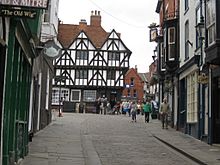
Some areas of the East Midlands have a special way of speaking. The region is also known for its traditional foods. These include Red Leicester cheese, the Lincolnshire sausage, the Melton Mowbray pork pie, Stilton, the Bakewell tart, and the Bramley apple.
D.H. Lawrence is a well-known author from the region. The Key Words Reading Scheme (Peter and Jane) was first made in 1964 by Ladybird of Loughborough. These books helped many children learn to read.
William Booth of Nottingham founded The Salvation Army in 1865. The Pilgrim Fathers came from Babworth near Retford. The Quakers were founded by George Fox from Leicestershire.
Joseph Wright of Derby was an artist whose paintings showed the ideas of the Age of Enlightenment. He was also called "the first professional painter to express the spirit of the Industrial Revolution." Charles Frederick Worth, born in Lincolnshire in 1825, is seen as the founder of Parisian haute couture (high fashion).
Industrial Heritage
The East Midlands is home to the world's first factory, Sir Richard Arkwright's Cromford Mill. The world's oldest working factory, producing textiles, is also here at Lea Bridge. Both are part of the Derwent Valley Mills, a World Heritage Site.
The UK's hosiery and knitwear industry was largely based in this region. The stocking frame (a knitting machine) was invented in 1587 in Calverton, Nottinghamshire. The world's first cotton mill powered by horses was built in Nottingham in 1768.
John Barber of Nottinghamshire invented a simple gas turbine in 1791. Lincoln was where the first tank was built in 1915. This tank, called Little Willie, is the oldest surviving tank in the world. The jet engine was first developed in Lutterworth and Whetstone. The first jet aircraft flew from RAF Cranwell in May 1941. During World War II, Derby was important because Rolls-Royce made their Merlin aero-engine there.
Derby was also a major railway workshop. The British Rail Research Division in Derby invented the APT and Maglev trains. The first steel rails were laid in Derby in 1857.
The collapsible baby buggy was invented in 1965 in Barby, Northamptonshire. Ford's large Daventry Parts Distribution Centre opened in 1972. It was the UK's largest building by floor area for many years.
The largest camera in the world was built in Derby in 1957 for Rolls-Royce. It weighed 27 tonnes. J. P. Knight of Nottingham is credited with inventing green and red traffic lights in 1868. Edgar Purnell Hooley, a Nottinghamshire surveyor, patented Tarmac in 1902. The first tarmac road was in West Bridgford in 1902.
Many famous toy companies were in the region. Mettoy in Northampton made Corgi Toys. Palitoy in Coalville was another famous firm. The first plastic DVD case was made in Corby.
Much research into integrated circuits was done at Caswell near Towcester. Torksey railway viaduct, built in 1849, is considered the first box girder bridge. The tallest freestanding structure in the region is the chimney of West Burton power station.
Second World War
Most of the region was protected by RAF Digby during the war. Only Nottingham was heavily bombed during the Blitz. This was because of a large Royal Ordnance factory there. However, much of the bombing of Germany was planned from the region. Two bomber groups were based in Lincolnshire.
Economy of the East Midlands
Manufacturing
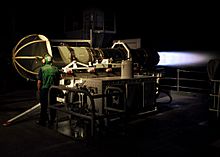
In 2003, manufacturing made up 23% of the East Midlands' economy. This was higher than the UK average of 15%.
For engineering, Rolls-Royce (the world's second-largest maker of aircraft engines) is in Derby. Siemens Industrial Turbomachinery makes industrial gas turbines in Lincoln. Triumph Motorcycles are in Hinckley. Cummins makes diesel engines in Daventry.
About 80% of the world's Formula One cars are made in Northamptonshire. Many racing teams and engine makers are based here. For example, Cosworth and MAHLE Powertrain are in Northampton. Mercedes AMG High Performance Powertrains is in Brixworth.
JCB Power Systems is near Foston, Derbyshire. Toyota Manufacturing UK makes cars like the Auris and Avensis in Burnaston. Bombardier UK makes trains in Derby. They built the Nottingham Express Transit trams and many UK train fleets.
Raleigh Bicycle Company is based in Eastwood. Ferodo in Chapel-en-le-Frith has made brake pads since 1897. Carbolite makes industrial furnaces in the Hope Valley.

FKI, which owns Brush Electrical Machines, is in Loughborough. John Taylor & Co in Loughborough is the largest bell foundry in the world. Eco-Bat Technologies in South Darley is the world's biggest producer of lead.

Tata Steel Tubes Europe is in Corby. Barnes Aerospace has its European headquarters in Derby. JJ Churchill makes turbine blades for jet engines in Market Bosworth. Sealed Air UK in Kettering makes Bubble Wrap. Abbott & Co.(Newark) Ltd in Newark makes pressure vessels.
Taylor Hobson (a company that measures things very precisely) is in Leicester. Gent (fire alarms), now owned by Honeywell, is also in Leicester. Abacus Lighting in Kirkby in Ashfield makes street lights and floodlights. Ardagh makes tin cans in Kirkby-in-Ashfield. Pandrol UK in Worksop makes parts for railway tracks.
Construction and Building Materials
Topps Tiles has its headquarters in Enderby. Aggregate Industries is based in Bardon. Mountsorrel has the largest granite quarry in Europe. BPB plc (British Plasterboard), the world's largest maker of plasterboard, is in East Leake.
Hörmann UK (which makes garage doors) is in Coalville. Barratt Developments (a housing company) is in Ellistown and Battleflat. Ibstock is the largest brick manufacturer in the UK. Roca UK makes sanitaryware in Coalville.
Caterpillar Building Construction Products makes construction machines like backhoe loaders near Desford. Terex Pegson makes mobile crushing machines in Coalville. SAME Deutz-Fahr UK, a tractor maker, is in Barby.

Charles Lawrence International in Newark makes materials for sports surfaces. Hewitt Sportsturf supplied the grass for the Olympic Stadium in 2011. Werner UK makes step ladders. Caunton Engineering, steel constructors, built the Olympics Water Polo Arena.
Textiles and Clothing
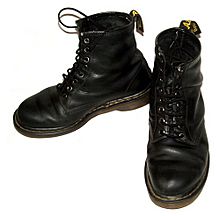
The fashion company Paul Smith is in Lenton. Speedo International Limited is in Nottingham. Its LZR Racer suit helped Michael Phelps win eight gold medals at the 2008 Olympics. Next, a large clothing company, is in Enderby. It is the largest company in the region by number of employees.
Boden (clothing) is in Leicester. Wolsey (clothing) is also in Leicester. Much of Britain's hosiery (socks and tights) is made in the region.
Many footwear companies are based in Leicester. Shoe Zone is one example. Loake makes shoes in Kettering and has a Royal appointment. Church's Shoes and Barker Shoes are in Northampton. Tricker's shoes in Northampton also have a royal warrant. Dr. Martens were made in Irthlingborough until 2003.
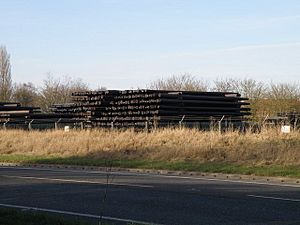
Sports Direct is based in Shirebrook. Wade Spring in Long Eaton makes springs for furniture. Sunspel in Long Eaton introduced the t-shirt to the British market. Duresta Upholstery is also in Long Eaton.
Wild Country makes rock-climbing equipment. Equip Outdoor Technologies owns brands like Lowe Alpine and Rab. Blacks Leisure Group was based in Northampton.
George at Asda, based at Lutterworth, became Britain's leading fashion retailer in 2009. TW Kempton in Leicester makes uniforms for the armed and police services.
Retail and Shops
Wilko head office is in Worksop. Games Workshop, which makes Warhammer miniatures, is in Lenton. Pendragon PLC, a car dealership, is in Annesley. Sytner Group is a luxury car retailer in Enderby.
Dunelm Group, a furnishings company, is in Syston. Pukka Pies are also made nearby. Jessops, a photographic equipment company, and Fox's Confectionery are in Leicester. Mark Jarvis (bookmaker) and Otis UK (lifts) are also in Leicester.
Avon Products UK is in Northampton. East Midlands Railway has its head office in Derby. Porterbrook, a train leasing company, is also in Derby. Sixt, a car rental firm, has its UK base in Chesterfield. Booker Group, a Cash & Carry company, is in Wellingborough.
Maclaren, the pushchair maker, is near Long Buckby railway station. BabyStyle is in Sileby. There are three main distribution centres in the area: Magna Park in Leicestershire, Brackmills, and the Daventry International Railfreight Terminal in Northamptonshire. J D Wetherspoon and Currys have distribution centres in Daventry and Newark-on-Trent. Tesco has its largest supermarket depot in the country at Kilsby.
Food Production
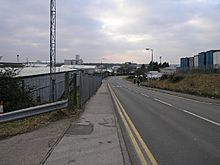
Silver Spoon makes all its demerara and brown sugar in Newark-on-Trent. Swizzels Matlow makes children's sweets in New Mills. Carlsberg beer has been brewed in Northampton since 1974. Cott Beverages UK is in Kegworth. Global Brands (maker of Vodka Kick) is in Clay Cross.
Greencore UK has a large factory in Worksop that claims to be the world's largest sandwich factory. United Biscuits has a big factory in Ashby-de-la-Zouch. They make KP Snacks like Hula Hoops and Skips. Oxo, Saxa salt, Super Noodles, and Bisto are made by Premier Foods in Worksop.
Cat food like Whiskas is made in Melton Mowbray by Masterfoods. Their Waltham Petcare Science Institute is a leading centre for pet food research. Samworth Brothers owns Ginsters and Soreen.
The crisp company Walkers makes 10 million bags of crisps a day in Beaumont Leys. This is the biggest crisp factory in the world. Pork Farms is in Lenton, Nottingham. Thorntons, a chocolate maker, is in Swanwick. Alpro makes soya milk products in Burton Latimer. Weetabix, a leading cereal brand, is in Kettering.
Long Clawson Dairy is the biggest producer of Stilton cheese in the UK. Faccenda Group in Brackley is the second largest chicken processor in the UK. Sealord UK makes all of Waitrose's white fish products near Caistor.
High Technology
Belkin UK (and Linksys) is in Rushden. Misco is in Wellingborough. RS Components is in Corby. Pegasus Software, which makes accounting software, is in Kettering. Serif Europe in West Bridgford developed PagePlus, one of the first affordable DTP software programs.
AVG Technologies has its UK head office in Newark. Experian, a credit-referencing company, has a large UK headquarters in Nottingham. Texas Instruments UK has its Semiconductor Design Centre in Northampton.
Finance and Services
Since 1997, Capital One, a credit card company, has had its European HQ in Nottingham. Experian, a credit-referencing company, was founded in Nottingham in 1980. Santander (formerly Alliance & Leicester) is based in Narborough. Barclaycard is headquartered in Northampton.
Castle Meadow Campus in Nottingham is a large HMRC site. It handles various tax services. Royal Mail has a main administrative centre in Chesterfield. Royal Mail also has its National Distribution Centre in Crick. About half of Britain's mail goes through there.
NatWest Group has a documents centre in Shepshed. It prints statements for England and Wales. Orion Security Print in Ilkeston produces cinema tickets. GeoAmey (prisoner transport) is in Whetstone.
Rural Economy
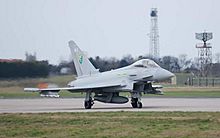
Lincolnshire and Rutland are very agricultural. A lot of the UK's crops are grown here. The RAF has many bases in this area. The main RAF College is at RAF Cranwell near Sleaford. The RAF's six AWACS aircraft are at RAF Waddington.
Lincolnshire is the second biggest potato producer in the country. It grows 30% of the country's vegetables. Interflora has its UK HQ in Sleaford. Lincolnshire is the world's leading producer of daffodils.
Princes has a large operation in Little Sutton. They can vegetables. Magnadata Group in Boston makes the UK's rail tickets. John Deere has its UK base in Langar. The British Geological Survey is in Keyworth.
Entertainment and Leisure
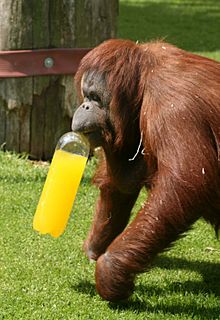
Skegness and the Lincolnshire coast offer seaside entertainment. This includes the Butlins resort at Ingoldmells. Nottingham and Leicester are popular for nightlife. Center Parcs UK is based at the Sherwood Energy Village in New Ollerton. The YHA is based in Matlock. Gala Bingo is based in Nottingham.
Twycross Zoo is in Leicestershire. The National Space Centre is in Belgrave in north Leicester. Carlsbro (electronics) is in South Normanton. Peavey Electronics UK (loudspeakers) is in Corby.
Rockingham Motor Speedway is in Corby. Other racetracks include Donington Park and Mallory Park in Leicestershire. Cadwell Park is in Lincolnshire. Silverstone Circuit hosts the British Grand Prix. Rutland Water is popular for sailing, fishing, and bird-watching. The Peak District National Park was the first national park in the UK, created in 1951.
Demographics of the East Midlands
The East Midlands has the second-lowest overall population density in England. This is partly due to the low population density in Lincolnshire and Rutland. In 2007, the region had fewer degree-educated people than the English average. About 29.5% of the population lives in rural areas.
Social Well-being

Overall, the East Midlands is less disadvantaged than the West Midlands and regions in the North of England. It has more areas that are among the least disadvantaged in England. This is similar to the South of England (excluding London). Experts say the region is a mix of north and south in terms of its economy.
The East Midlands does not show the typical economic features of Northern England. It is also not as wealthy as large parts of Southern England. Economically, it is similar to South West England.
In March 2011, the average unemployment rate for the region was 3.6%. Nottingham and Leicester had the highest rates at 5.8% each. Rutland and South Northamptonshire had the lowest rates at 1.4% each.
Elections and Politics
In the 2015 general election, 43% of voters in the region chose the Conservative party. 32% voted Labour. The Conservatives won 32 seats, and Labour won 14 seats. Labour's seats were mainly in Derby, Leicester, Nottingham, and the East Midlands coalfield areas. Northamptonshire, Rutland, and Lincolnshire are entirely Conservative.
In 2009, Nottinghamshire and Derbyshire county councils changed from Labour to Conservative control. All the main county councils in the region are now controlled by the Conservatives.
| Number of MPs returned per party, total 46 (situation at end of parliament in brackets) |
|||||||||
|---|---|---|---|---|---|---|---|---|---|
| Affiliation | 2010-15 | 2015-17 | 2017-19 | 2019-present | |||||
| Conservative Party | 30 | 32 | 31 (28) | 38 | |||||
| Labour Party | 16 | 14 | 15 (13) | 8 | |||||
| Change UK | 0 | 0 | 0 (2) | 0 | |||||
| Independent | 0 | 0 | 0 (3) | 0 | |||||
Sports in the East Midlands
The region has a strong sporting history. Many famous sports personalities come from here. For example, David Gower (cricket), Gary Lineker (football), and Rory Underwood (rugby).
The British Gliding Association is in Leicester. The National Ice Skating Association is in Nottingham. The British Caving Association is at Great Hucklow. The British Canoe Union is in Bingham.
The first 1978 BDO World Darts Championship was held in Nottingham in 1978.
Football Clubs
Notts County F.C. is the world's oldest professional football club. Nottingham Forest F.C. is the oldest football league side after Notts County's relegation in 2019. Sam Weller Widdowson introduced shin pads in 1874. The first referee's whistle was used in Nottingham in 1872.
Admiral Sportswear in Wigston made the England football strip from 1974 to 1982. They were the first company to sell replica kits.
The East Midlands has several professional and semi-professional football clubs:
| Team | Location | League 2019-20 |
|---|---|---|
| Leicester City | Leicester | Premier League |
| Derby County | Derby | Championship |
| Nottingham Forest | West Bridgford | Championship |
| Peterborough United F.C. | Peterborough | Championship |
| Lincoln City | Lincoln | League One |
| Grimsby Town | Grimsby | League Two |
| Mansfield Town | Mansfield | League Two |
| Northampton Town | Northampton | League Two |
| Scunthorpe United | Scunthorpe | League Two |
| Chesterfield | Chesterfield | National League |
| Notts County | Nottingham | National League |
| Alfreton Town | Alfreton | National League North |
| Boston United | Boston | National League North |
| Brackley Town | Brackley | National League North |
| Kettering Town | Kettering | National League North |
Rugby Union Clubs
The East Midlands has two top-level rugby union clubs.
Leicester Tigers are based in Leicester. They are one of the most successful rugby teams in Europe. They have won the European cup twice and the English league ten times.
Northampton Saints are from Northampton. They play their home games at Franklin's Gardens. Their biggest rivals are the Leicester Tigers. The "East Midlands Derby" is a very strong rivalry in English Rugby Union.
Cricket Clubs
Nottinghamshire (Trent Bridge), Leicestershire (Grace Road), Derbyshire (County Cricket Ground, Derby), and Northamptonshire (County Cricket Ground, Northampton) all play in the T20 North group.
Basketball Clubs
Leicester Riders are the oldest basketball club in Britain. They were founded in 1967. They play at Leicester Arena.
Motor Sports
RML Group (a motorsport team) is in Wellingborough. Bamboo Engineering is at Silverstone.
Swimming
The Amateur Swimming Association is the world's first swimming governing body. It was founded in 1869 and is now based in Loughborough. British Swimming has an Intensive Training Centre at Loughborough University.
Education in the East Midlands

Secondary Schools
Most secondary schools in the East Midlands are comprehensives. However, Lincolnshire still has fifteen state grammar schools.
There are about 180,000 students in the region's secondary schools. This is the second lowest number of students in any English region. Some city schools in the East Midlands have higher rates of students missing school than the national average. Rural schools tend to have lower rates.
Schools in Nottingham City and some in Leicester often have lower GCSE results. Rutland is one of the highest-performing areas for GCSEs in the region. Leicestershire and Derbyshire also usually have GCSE results better than the national average.
For A-level results, Nottinghamshire, Lincolnshire, and Derbyshire often perform better than the national average. Nottingham's A-level results are usually better than its GCSE results.
There are eighteen further education colleges in the region. These include New College Nottingham, Central College Nottingham, Leicester College, and Lincoln College.
Top State Schools for A-levels (2015)
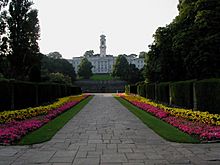
- Caistor Grammar School
- The Becket School, West Bridgford
- Brooke Weston Academy
- The King's School, Grantham
- Kesteven and Sleaford High School
- Queen Elizabeth's Grammar School, Ashbourne
- West Bridgford School
- The Ecclesbourne School
- Queen Elizabeth's High School, Gainsborough
- William Farr School, Welton
- The Priory Academy LSST, Lincoln
- King Edward VI Grammar School, Louth
- Queen Elizabeth's Grammar School, Alford
- Spalding High School
- Branston Community Academy
- Lady Manners School, Bakewell
- Anthony Gell School, Wirksworth
- Dronfield Henry Fanshawe School
- Bourne Grammar School
- Queen Elizabeth's Grammar School, Horncastle
Universities in the East Midlands

The universities in the East Midlands include:
- University of Derby
- University of Leicester
- Loughborough University
- University of Northampton
- University of Nottingham
- Nottingham Trent University
- Bishop Grosseteste University (Lincoln)
- University of Lincoln
The region has the lowest number of part-time students in England. More young people come into the region for university than leave to study elsewhere. Only 25% of students doing a first degree are from the East Midlands.
Images for kids
See also
 In Spanish: Región de las Tierras Medias Orientales para niños
In Spanish: Región de las Tierras Medias Orientales para niños



